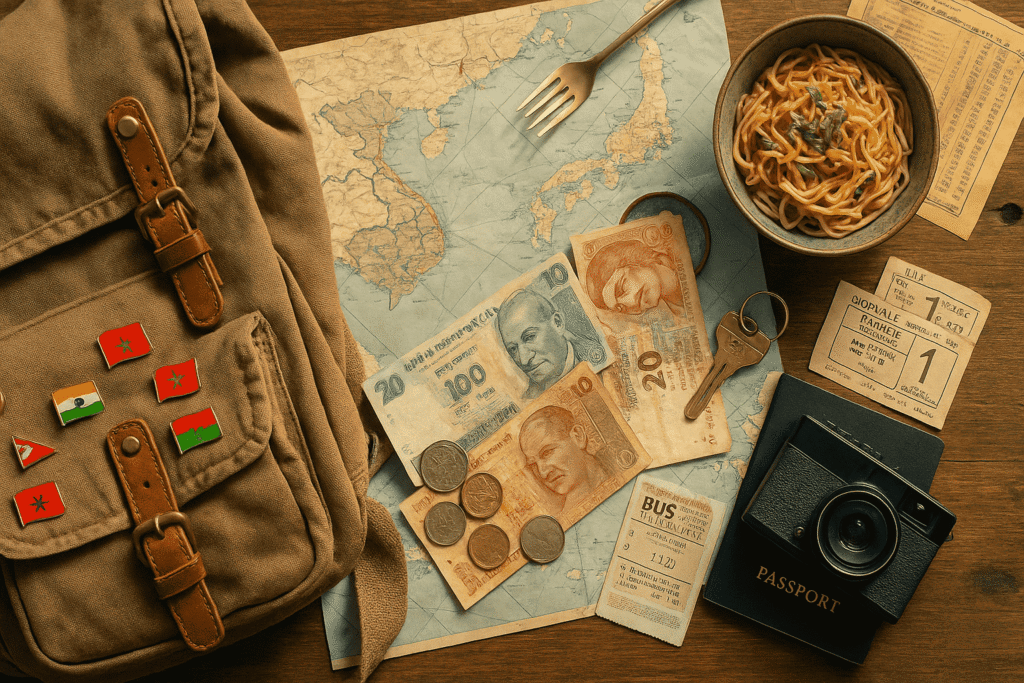It’s a data-led short list of countries where a traveler can cover daily needs—bed, meals, local transport, basic sightseeing—on roughly $15–$40 per day (≈ €13–€34) in 2025, depending on location and style. Picks are grounded in PPP (purchasing power parity), backpacker price baskets, and traveler-reported costs, then checked against current exchange rates and visa fees.
Why These Countries? The Method Behind the Money
I used three pillars. First, purchasing power parity (PPP) to understand how far a foreign currency goes in each economy. The latest round of the World Bank’s International Comparison Program (ICP) gives robust PPP anchors for cross-country price levels. PPP isn’t a travel budget, but it tells us where a dollar buys more goods and services.
Second, I layered in city and country budget baskets from traveler-grounded datasets. Price of Travel’s 2025 Backpacker Index ranks dozens of cities on a fixed “backpacker day” (hostel bed, local transport, two cheap meals, one paid attraction, drinks). I paired that with BudgetYourTrip’s country pages, which aggregate real trip spends into budget / mid-range / luxury daily averages.
Third, I adjusted for currency moves and entry costs. Exchange rates matter: using the European Central Bank’s reference rates for late September 2025, US$1 ≈ €0.85, so the euro figures below are approximations at that rate. And visa fees can move the needle—e.g., the Schengen short-stay visa rose to €90 on 11 June 2024.
Data Sources & How to Read the Numbers
Daily ranges below are shoestring to frugal-comfortable (hostel/private room mix, public transport, street food + a sit-down meal, one paid site). In very touristy centers, expect the high end; in secondary cities and rural areas, aim for the low end. Always cross-check big swings with city-level indices for your exact route.
| Country (Top value cities) | Typical Daily Budget (USD / ≈EUR) | Notes |
|---|---|---|
| Vietnam (Hanoi, Huế, HCMC) | $20–30 / €17–26 | Consistently top of backpacker rankings; strong street-food value. |
| India (Delhi, Jaipur, Kochi) | $18–25 / €15–21 | Ultra-low eats & trains; city prices vary widely. |
| Nepal (Kathmandu, Pokhara) | $15–25 / €13–21 | Best value off-season; trekking permits add cost. |
| Laos (Vientiane, Luang Prabang) | $9–20 / €8–17 | Among the cheapest city baskets in Asia. |
| Cambodia (Phnom Penh, Siem Reap) | $26–35 / €22–30 | Angkor fees are separate; otherwise very low day-to-day costs. |
| Indonesia (Java, Sumatra) | $25–35 / €21–30 | Cheapest in Java/Sumatra; Bali tourist zones cost more. : |
| Sri Lanka (Colombo, Ella) | $22–35 / €19–30 | Iconic trains; inland stays excellent value. |
| Georgia (Tbilisi, Kutaisi) | $14–30 / €12–26 | Budget rooms & meals are inexpensive beyond Tbilisi’s core. |
| Armenia (Yerevan, Dilijan) | $16–30 / €14–26 | Transit and food are cheap; great for hikers. |
| Morocco (Fes, Chefchaouen) | $30–40 / €26–34 | Riads & long-distance trains are good value; haggle taxis. |
| Egypt (Cairo, Luxor) | $17–30 / €14–26 | Attractions add up, but day costs remain low. |
| Bolivia (La Paz, Sucre) | $25–35 / €21–30 | One of South America’s best values; tours extra. |
Sources include city-level “Backpacker Index” baskets and country-level traveler budget aggregates; euro figures approximate US$→€0.85 at late-September 2025 ECB reference rates.
Regional Picks & Sample Low-Cost Routes
Asia (ultra-budget) — Stitch Vietnam–Laos–Cambodia or Sri Lanka into 2–4 weeks. Example: Hanoi → Da Nang (~475 miles / 766 kilometers) by rail or bus, then hop south or overland to Laos/Cambodia. Long segments are cheap and frequent.
Europe & the Caucasus (best value in Europe) — Georgia and Armenia deliver mountain hikes and monastery towns at dinner-for-two prices that feel pre-euro-boom. Add eastern Balkans if you want Europe on a budget; Serbia in particular has low day-to-day spends outside peak festivals.
Africa & MENA (culture hits under €40/day) — In Morocco, trains connect imperial cities cheaply; Marrakesh ↔ Fes is about 253 miles (408 km) and takes 6–7 hours by train. Egypt remains inexpensive on food and stays; plan for paid sites and optional flights between Nile cities.
Latin America (Andean bargains) — Bolivia is a standout; buses are cheap and hostel beds widely available. Tours like Uyuni add cost but are exceptional value compared with Patagonia.
Real Costs Many Travelers Forget
Visas & authorizations. Small fees change your “true” daily cost. Example: Schengen short-stay visas increased to €90 (adults) and €45 (ages 6–11) on 11 June 2024. Build this into Europe itineraries if you need a visa.
ATM, SIM & payments. Pre-trip debit cards can save 2–3% in fees; buy local eSIMs instead of roaming. In Morocco, for instance, 4G data is inexpensive via major networks (Orange, Maroc Telecom).
Ground transport. Long hops are cheaper than you think—e.g., Colombo → Ella is roughly 125 miles (201 km) by rail or road, but the scenic train takes time; buses can be faster and cheaper. In Egypt, trains may cost foreigners more than before, so compare early-bird domestic flights on long legs.
Seasonality & inflation. In 2025, many emerging markets kept prices low in dollar terms thanks to currency moves, while headline inflation in the OECD hovered around the mid-single digits—plan buffers. A strong dollar also improved value across parts of Asia this year.
Safety, Timing & Practical Tips
Check official advisories before you lock routes; guidance can shift quickly. Use your government’s travel-advice portal for country-specific updates and local rules.
Target shoulder seasons. You’ll see hostel beds 15–30% cheaper and fewer crowds. Book long-distance trains or overnight buses a few days early on popular corridors (Vietnam’s Reunification line; Morocco’s ONCF).
Stretch your budget ethically. Pay posted prices at museums and parks; tip fairly; consider family-run guesthouses over chain hotels. In ultra-cheap markets, a couple of extra dollars can meaningfully support local businesses.
Build Your Budget: A Simple Daily Template
Use this baseline for $30/day (≈ €26) in a classic budget country (e.g., Vietnam, Nepal), and scale up/down:
- Bed: $8–12 (hostel dorm / basic guesthouse)
- Food: $10–12 (street food + one sit-down meal)
- Local transport: $2–4 (bus/metro; occasional rideshare)
- Attraction(s): $2–4 (one paid site)
- Miscellaneous: $2–4 (SIM data, water, snacks)
On transit days, shift attraction spend to buses/trains; on “splurge” days, add $10–15 for an experience (cooking class, canyoning, museum pass). If your route includes pricier hubs (e.g., Bali’s Canggu, Morocco’s medina riads), bump lodging by $5–10.
FAQ
Is Japan or South Korea budget-friendly in 2025?
Not “ultra-budget,” but the strong US dollar made East Asia more affordable for Americans in 2025 than in recent years, especially outside capital cities and in business hotels. Watch exchange rates when you book.
How much should I budget for visas in Europe?
If you need a Schengen visa, plan €90 for adults or €45 for ages 6–11 per application, plus service-center fees where applicable. Some nationalities are visa-exempt; always check official EU sources before applying.
Are country averages reliable for my exact route?
They’re a starting point. Combine country averages with city-level baskets (e.g., Backpacker Index) and your personal style. Big tourist zones can be 30–60% higher than small cities; rural areas can be lower.
What Did We Learn Today?
- Ultra-budget daily targets of $15–40 (≈ €13–€34) are realistic in 2025 across parts of Asia, the Caucasus, North Africa, and Bolivia.
- PPP, city baskets, and traveler averages together give the clearest picture—no single metric is enough.
- Entry fees and exchange rates matter: US$1 ≈ €0.85 (late-Sep 2025), and Schengen visas now cost €90 for adults.
- Trains and buses keep costs low on classic routes like Hanoi–Da Nang (≈ 476 mi / 766 km) and Marrakesh–Fes (≈ 253 mi / 408 km).
- Timing beats haggling: travel in shoulder seasons and book key legs early for the best value.





